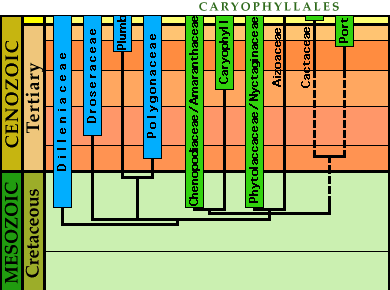







The oldest caryophyllid fossils date from the Maastrichtian age of the latest Cretaceous. Although the caryophyllids today include nearly seven percent of all species of flowering plants, the group is not commonly found as fossils. Some groups of caryophyllids, such as the Plumbaginaceae, have left only traces in the form of fossil pollen. Others, such as the Cactaceae, are known as fossils only from a few bits of debris in ground sloth dung. The Aizoaceae, another succulent group, has left no fossils at all. Only a couple of caryophyllid groups have left leaves or other large fossils for us to find, and even those fossils are rare compared to those of other angiosperm groups.
Why are caryophyllid fossils so rare? One possibility is that the ancient caryophyllids were not so numerous as their living descendants. This does not mean that there weren't a lot of species, but perhaps none of these species produced large numbers of individuals. With few individuals around, fossils would be less likely to be left behind. A second possibility is that caryophyllids did not grow in habitats where fossils are likely to be formed. Many members of this group, such as the desert-dwelling cacti, live in arid regions, and these places are not conducive to the creation of plant fossils.
A final possibility is that we haven't found many fossil caryophyllids simply because we haven't been looking in the right places. Some cacti and many other caryophyllids live in the tropics, and very little paleontological exploration has been carried out in that part of the world. It may be that one day when more fossil hunting has been done in tropical climes, we will find many more fossils for this group.

Stratigraphic Ranges of Caryophyllids : The chart above combines information about the relationships among caryophyllid lineages with the dates of their known fossils. The green bars at right belong to the order Caryophyllales, while the four blue bars at left represent the remaining basal caryophyllid groups. Most appearance dates come from Muller (1981), with additional information from the UCMP Paleobotanical Collections.
Dill. = Dilleniaceae; Plumb = Plumbaginaceae; and Port = Portulaccaceae. See the text below for interpretation.
The chart above presents a phylogeny of the caryophyllids, where the lines representing each lineage are constrained to match the dates of the oldest known fossils. Each wide colorful bar represents one caryophyllid group, and its lower end corresponds with the date of the earliest known fossil for that group. Approximate ages may be determined by using the thin horizontal "background lines". These lines subdivide the Tertiary into its component epochs, and the thin line in the Mesozoic delineates the Maastrichtian age of the latest Cretaceous.
Note that the time of divergence between the Cactaceae (cactus family) and the Portulaccaceae is speculative, and so is represented by a dashed line -- it is not possible to tell when this event happened. Likewise, the split between the Polygonaceae and Plumbaginaceae may have happened in the Paleocene rather than the Cretaceous, as it is depicted in the diagram. Finally, note that the earliest evolutionary events are compressed together in the Maastrichtian. If the the group underwent a rapid origin at that time, then this diagram is correct. However, fossils of other flowering plant groups are known from much earlier, and it is possible that additonal earlier caryophyllid fossils may be found that will lengthen these basal branches. Thus, a rapid caryophyllid origin is merely speculation here as well, and is made in the absence of any data favoring or refuting the idea.
By using this approach of combining evolutionary relationships with evidence from the fossil record, it is possible to see that several of the lineages with poor fossil records must have come into existence long before they began leaving fossils. The ancestors of the Caryophyllaceae (carnation family) and the Aizoaceae (a large group of succulents) were present as distinct groups before the dinosaurs went extinct. So why haven't we found their fossils in Cretaceous rocks? Besides some of the possibilities given earlier on this page, it is quite likely that the early members of these lines had not yet evolved their groups' characteristic features. For example, we know from our phylogeny above that the Aizoaceae is closely related to the Phytolaccaceae and Nyctaginaceae, and they all descended from a close common ancestor that lived in the Cretaceous. But the Aizoaceae and Nyctaginaceae look very different from each other today. The Aizoaceae includes rock-plants and other succulent species, while the Nyctaginaceae includes things like Bougainvillea.
At some point in their evolutionary history, each group began to acquire the distinctive characteristics that allow us to recognize the group. These changes may have happened early in the Phytolaccaceae and Nyctaginaceae, and so we can recognize fossils of those groups in the Cretaceous. Or the changes may have occurred at a later time, in which case we might find a fossil Aizoacean without recognizing what we had found. This is not a problem with just the caryophyllids, but is a general difficulty in all of paleontology.

S. Magallón, P. R. Crane, & P. S. Herendeen, 1999. Phylogenetic Pattern, Diversity, and Diversification of Eudicots. Ann. Missouri Bot. Gard. 86(2):297-372.
Jan Muller, 1981. Fossil pollen records of extant angiosperms. The Botanical Review 47(1):1-142.

